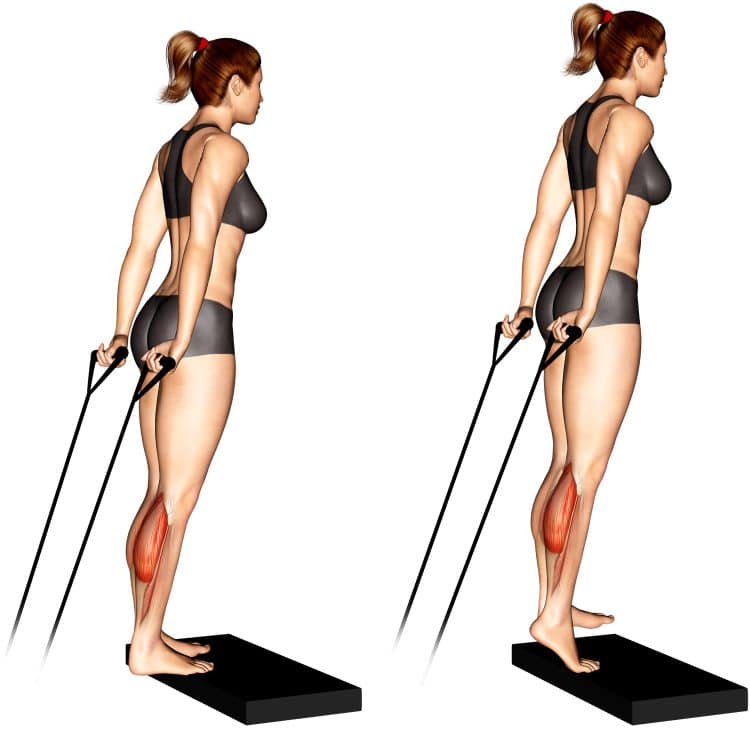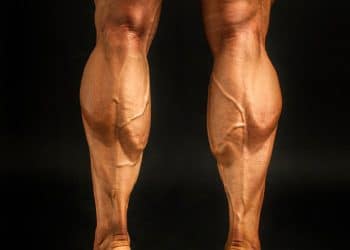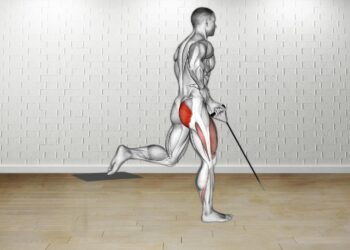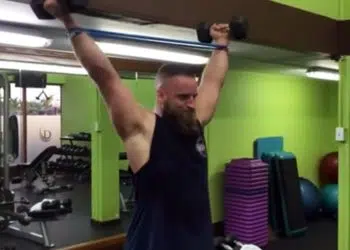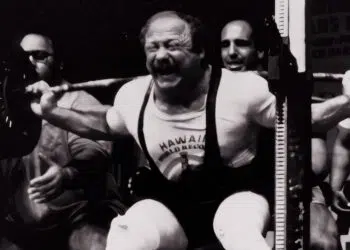Unless you found the line handing out plump, aesthetic calves (A lot of us weren’t so lucky), then you’ve probably been called chicken legs by someone (Well, you could be called worse). While it’s true your parents have a lot to do with the shape, size, and length of your lower leg muscles, you can always make small calves bigger. Don’t expect to have full-sized cows, but baby bulls are totally reasonable.
Or maybe you have good calves but want some home-training ideas to fatten them up a bit. Perfect, you came to the right place because today you’ll learn the art of band calf raises. This guide will be a top source for tips on loading techniques, common mistakes, band selection, and anything else you should know about band calf training.
So let’s not waste anytime…
In This Exercise:
- Target muscle group: Calves
- Type: Hypertrophy
- Mechanics: Isolation
- Equipment: Resistance band
- Difficulty: Beginner/intermediate
Muscles Worked During Band Calf Raise
The calves are a tri-muscle group, collectively called triceps surae (Nothing to do with your arms) with unique fibers contributing a separate role in the posterior leg. We want you to really understand their anatomy and why you need variety in your calf training to blow up your bulls to max capacity!
Gastrocnemius
Most people associate the calf muscles with the gastrocnemius and rightly so. It’s the largest calf muscle in the lower leg, creating majority of its appearance and shape. When you walk and run, the gastrocnemius most visibly flexes. It’s designed by nature to plantar flex the foot (The same as lifting up onto your tiptoes) and flex the knee (Bending the leg), crossing through both joints.
Level Up Your Fitness: Join our 💪 strong community in Fitness Volt Newsletter. Get daily inspiration, expert-backed workouts, nutrition tips, the latest in strength sports, and the support you need to reach your goals. Subscribe for free!
Soleus
Largely hidden by the gastrocnemius, the soleus doesn’t interfere with the knee like the former. Soleus is a long muscle that’s wedged between just below the knee and above the ankle where it forms your achilles tendon, with the gastrocnemius. It is wide, and does the same, allows you to press the toes down, like when you press a gas pedal.
Like gastrocnemius, soleus is important for walking, running, jumping, and posture.
Plantaris
Typically not mentioned as part of your calves, plantaris muscle is the little brother out of the three. That’s because it has a much less significant role, and is a weak helper to plantarflex the foot, and flex the knee. Formed with the gastroc, plantaris runs down the leg and ends on the medial heel bone next to the achilles.
How To Do The Band Calf Raise
There happen to be several ways to a band calf raise. It’ll also depend on the type of band you have, and whether or not you have a raised platform for greater range of motion. But don’t overcomplicate things.
Here are step by step instructions and two solid video demonstrations with exercise explanations of proper band calf raise technique.
Steps
- Grab a long looped band find a base of support like a rack, wall, or table.
- With either foot, step down on the band with your toes, and not the middle of your foot.
- Then grab the other end of the band with the same side hand, palm facing up.
- Lift the band up to your shoulder in the front rack position, as if you were going to do an overhead press.
- Hold onto your base with the free hand for support.
- Bring the non-working leg up off the floor, and press it up against the back of the working leg if it’s more comfortable.
- Keep your leg straight, then push your toes down into the band until your heel is lifted as much as possible. Squeeze your calves muscles hard.
- Slowly drop your heel to the floor then continue until you’re satisfied with the number of reps.
- Switch your feet to work the opposite side.
You can alternate legs for sets or do all sets on one leg first then switch to the other.
You can also use the following technique, which may be more convenient and easier for some. You’ll anchor the band to something low to the ground like a door attachment or rack. Then you can hold the bands in front of you or behind your back and that way you don’t have to step on the bands with your feet.
Tips
- If you’re carrying a lot of excess bodyweight, then we recommend the two legged calf raise on a level floor surface, not using a raised platform. The reason being, you cannot adjust your body weight and it may cause too much stress on the ankle area if using a full range of motion.
- If the calf raise feels too easy, consider doing them on one leg, or from a raised step.
- Stack bands together or go up in resistance once you can do 25+ reps.
Benefits of Band Calf Raises
What edge does a band raise give you over weights and machines?
Machine or weighted alternative
Cheaper, lighter, small enough to put in your gym bag, and safer, bands offer all of these advantages over weights and machines. And that’s why it’s the ultimate home or outdoor training tool.
For band calf raises, the looped variation are better than the tubes for many reasons. They offer more resistance, are flat (Easier to anchor down with your feet), and more comfortable to hold.
Build stronger, more athletic lower leg muscles
The calves are crucial athletic muscles. They, along with your quads, hamstrings, and glutes give you explosive power, and allow you to run, jump, and perform fast paced, high intensity physical activities. So training them only makes sense, as you’ll build stronger and more resilient calf muscle.
Affordable resistance
Rubber’s cheaper than cast iron, and it just works. You can pick up a heavy band with handles for a fraction of the cost, or get a set of them for you’d pay to to train at a gym for a month.
Drawbacks of Band Calf Raises
Where does a band calf raise fall short? Here are some ways.
Not a dedicated calf machine
When we don’t have the best resources, we do what we got to do to compromise. While a single resistance band can be used for a variety of exercises to target any body part, calf raise machines are engineered specifically for ergonomic calf training.
So you tell us which one is better overall… but band calf raises are better in their own way like when you can’t use machines, or combined with other machine-free variations.
You control the resistance
When we get put in the charge of the resistance, things get a little tricky. Bands come without markings and you have to experiment with different variables to get the right resistance, and to know when and how to progress.
This isn’t a problem if you’re consciously aware of how your training or if you have multiple bands of varying resistance. You still need to focus and keep track of your progress with bands.
Common Mistakes During The Band Calf Raise
Believe it or not, doing band calf raises wrong can be a regretful decision. Take heed to the following tips, and avoid these common mistakes.
Not warming up
This mostly applies to performing calf raises from an elevated platform like steps, where you can drop the heel down further than if doing them on a level surface. It’s even more crucial for overweight or obese exercisers with limited exercise experience.
Level Up Your Fitness: Join our 💪 strong community in Fitness Volt Newsletter. Get daily inspiration, expert-backed workouts, nutrition tips, the latest in strength sports, and the support you need to reach your goals. Subscribe for free!
The worst thing to do is let your heel drop under your weight without any control. This can have an unpleasant impact your ankle and achilles tendon area, and you’ll feel it.
We recommend doing warm up sets on the floor first, then easing yourself into a larger range of movement by performing short reps from step. Then, after a few sets of warmups, you can drop a heel a little lower to get a more pronounced stretch in your calves.
Not challenging yourself
You’ve got to find a way to progress otherwise your efforts may be in vain. For band calf raises, we recommend following a tier system to ensure you’re making steady gains.
For example, you can start with a two legged band calf raise, then move to one leg, and when you feel ready, perform them off a raised object like stairs, doorstep, etc. And then if you still need more of a challenge, you can invest in heavier resistance bands.
You should always be aiming for a combination of more reps and heavier resistance. The calves are stubborn muscles to get growing so don’t be afraid to go heavy, so long as you can get a decent range of motion.
Applying uneven and inconsistent loads
What you do on one side, make sure to do the exact same thing on the other. That means ensuring the band is of equal length when training the left and right side. Hold it in the same spot, and make sure your feet placement is identical. You should also make sure that you’re performing the exercise with the same range of motion for each foot.
While the calves are darn stubborn to grow, you still need to ensure you build asymmetrical strength.
Variations and Alternatives of Band Calf Raises
Assuming band calf raises are used as a home training gym alternative, or machine-free variation, these variations are suitable substitutes. Then, of course, we included alternative options which consists of the best calf raise exercises overall.
Bodyweight calf raise
It’s entirely possible to train your calves without any added resistance. In fact, oftentimes we underestimate just how effective bodyweight only calf raises can be. While machines are the bee’s knees, some of us have no business using them as we stack on way too much weight and don’t understand how to train calves in the first place.
Deep squat calf raise (Bodyweight)
It gets even better with this bodyweight only variation. Performed from a deep squat with your butt close to your ankles, you don’t have the ability to use momentum. It’s just pure calves!
BUT…
If you have bad knees, then avoid this exercise as it places extreme pressure on the knee joint.
Steps
- Drop your butt down onto your ankles and sit in a deep squat.
- Shift your weight forward onto the balls of your toes.
- Keep your back straight, rest your elbows on your thighs, then drive your toes into the ground and squeeze your calves.
- Gently drop your heels to the floor then repeat as many times as needed to pump up your calves!
Pro tip: Place your fingers on the floor to help assist and/or ease the load on your knee joints.
Deep squat calf raises are also great to help increase mobility in the ankles before a squat workout.
Half squat calf raise
So this one is still just using your body weight, but better on the knees although maybe not be quite as challenging. But a solid option no doubt. And again, it’s hard to cheat when you’re in this position.
- Squat down only halfway, and hold onto something in front of you for support. Then raise up onto your toes and squeeze the calves mighty hard. Gently drop the heels and repeat until your legs are screaming.
Free weight calf raise
Referring to a dumbbell, barbell, or any weighted object that’s not a band or machine. If you’ve got either of the two aforementioned implements lying, you can do weighted calf raises.
A heavy barbell is an excellent way to lift submaximal loads and really build strength in the legs. Dumbbells are better for performing calf raises from a step as you can hold on with the non working side, and get a nice stretch and great movement in the ankle joint.
Machine calf raise
The elite choice for calf training, whether seated or standing, calf raise machines offer the best overall way to blast your baby bulls!
These contraptions are designed for you to be able to jump right into the exercise. Equipped with raised foot plates for increased range of motion, thigh (Seated) or shoulder (Standing) cushions and built in pin adjustable weight stack or free weight pegs.
The Smith machine is another great option as you can use a weight plate to increase the range of motion. Although there is more setup time, as you’ll need to find a good angle.
Related: The 13 best calf raise machine alternatives for bigger, stronger lower legs.
Cable calf raise
The advantages cables have over bands are comfort, convenience of a pin adjusted weight stack, consistent resistance (No stretching needed to increase the resistance), and not having to hold the handle at shoulder level.
FAQs
How many sets and reps should I do for best results?
You can utilize various strategies when training the calves. For example, you can pyramid up in weight for each subsequent set, going from a higher to lower rep range. Or you could implement drop sets where you perform a few heavy reps then drop the weight by a certain percentage, pump out more reps and repeat until you achieve a desired number of reps.
You might even like to do short and fast pulse reps using a shorter range of motion. Although this is better at the end of a calf workout.
How much resistance is needed to grow my calves bigger?
Don’t focus so much on the weight load at first, but more on gradual progression, technique, and safety. You don’t want to jump right into super heavy sets and place an unnecessary load on the ankle and foot. As over time this can cause long term issues.
Instead, use light to medium heavy loads and work on range of motion, and feeling the contraction in your calf muscles. Then, you can implement progressive overload via a combination of adding extra reps with the same weight and increasing the resistance.
Overtime, you’ll get stronger and your body can better adjust to higher intensity training.
What is meant by stubborn calves?
Many experts would agree that the calves, as well as the forearms more commonly do not respond to training like most muscle groups. It can often feel like you’ve tried every technique in the book, and are just spinning your wheels. Well, it’s true that genetics determine the appearance of your calves, like any muscle, and some people will never have huge muscular calves as it’s not in their DNA.
But… EVERY muscle can grow. With the right training, diet, and body weight you can have bigger, and most definitely stronger calf muscles.
If I have small calves, can I make them big?
It depends on what “big” means to you. It’s possible with the right genetics, training habits, and diet. You’ll probably need to gain some muscle weight or be patient an keep training hard.
I'm training my calves a lot, with heavy weights and various techniques, but they're not budging.
One often overlooked reason for this is that if you’re on the thinner side, you may need to gain muscle weight by increasing your calorie and protein intake. You won’t go from small to big without adding size to your body.
If you’re the exact opposite, however, you may need to drop body fat to see your muscle progress.
How often should I train my calves?
There’s a common belief that the calves are more resistant to training than other muscles because we walk on them all day. So if you want them to grow you need to train them heavier and more frequently. While there could be truth to this, they are still a muscle, and muscles need time to recover.
We would combine heavy low rep and lighter high rep training to ensure the calves are not being overtrained and have time to repair.
Wrapping Up
Well, how are your baby bulls coming along? Are you feeding them a steady diet of band calf raises and other variations? Do you implement progression techniques like more reps and higher loads? If so, they should be fattening up in no time, with some decent muscle gains of course. But also remember your diet and body weight will determine the growth rate as well.
Sometimes they can be rebellious as its in their genetics, but don’t give up, and try different ways to get them to respond. It’s all in the fun of training.
Interested in measuring your progress? Check out our strength standards for Machine Calf Raise, Half Squat, Squat, and more.

